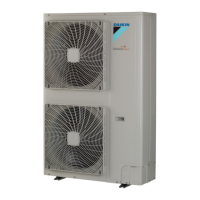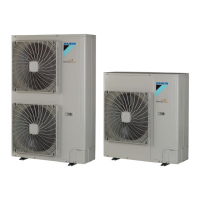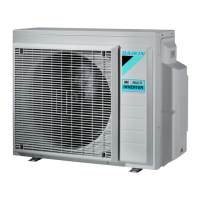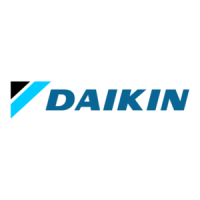8 | Piping installation
Installer reference guide
41
EKHWET90~120BAV3
R32 Split series – Domestic hot water tank
4P680077-1 – 2021.11
▪ Field supply components – Water. Only use materials that are compatible with
water used in the system and with the materials used in the indoor unit.
▪ Field supply components – Water pressure and temperature. Check that all
components in the field piping can withstand the water pressure and water
temperature.
▪ Water pressure – Domestic hot water. The maximum water pressure is 4 bar
(=0.4MPa). Provide adequate safeguards in the water circuit to ensure that the
maximum pressure is NOT exceeded. The minimum water pressure to operate is
1bar (=0.1MPa).
▪ Water temperature. All installed piping and piping accessories (valve,
connections,…) MUST withstand the following temperatures:
INFORMATION
The following figure is an example and may NOT completely match your system
layout
EXAMPLE
(*) Maximum temperature for piping and accessories
▪ Air vents. Provide air vents at all high points of the system, which must also be
easily accessible for servicing.
▪ Non-brass metallic piping. When using non-brass metallic piping, insulate the
brass and non-brass properly so that they do NOT make contact with each other.
This to prevent galvanic corrosion.
▪ Valve – Change‑over time. When using a 2-way valve or a 3-way valve in the
water circuit, the maximum change-over time of the valve must be 60seconds.
▪ Domestic hot water tank – Capacity. To avoid stagnation of water, it is
important that the storage capacity of the domestic hot water tank meets the
daily consumption of domestic hot water.
▪ Domestic hot water tank – After installation. Immediately after installation, the
domestic hot water tank must be flushed with fresh water. This procedure must
be repeated at least once a day the first 5 consecutive days after installation.
▪ Domestic hot water tank – Standstills. In cases where during longer periods of
time there is no consumption of hot water, the equipment MUST be flushed with
fresh water before usage.
▪ Thermostatic mixing valves. In accordance with the applicable legislation, it may
be necessary to install thermostatic mixing valves.
▪ Hygienic measures. The installation must be in compliance with the applicable
legislation and may require additional hygienic installation measures.
▪ Domestic hot water tank – Disinfection. For the disinfection function of the
domestic hot water tank, see "10.6.2Tank"[470].

